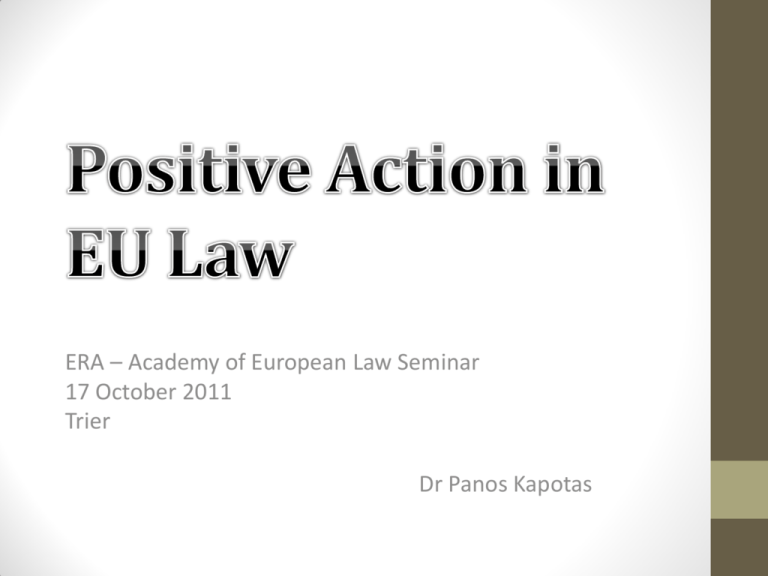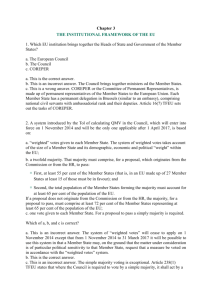Positive Action in EU Law - era
advertisement

ERA – Academy of European Law Seminar 17 October 2011 Trier Dr Panos Kapotas General Overview • Part A: Definitions / Theoretical Background / Types of Positive Action • Part B: Positive Action in EU Law Normative framework ECJ case-law • Part C: Critical Reflections POSITIVE ACTION IN EU LAW: KEY POINTS • Permissible (under certain conditions) – not compulsory (no positive obligation) • Employment Law as the normative framework par excellence • Gender as the principal dimension, but permissible on other grounds as well • Inequalities as a necessary condition to trigger positive measures (disadvantage and / or under-representation) • Quotas (“strict” positive measures) as our principal focus Working Definition Positive action is an umbrella term that accounts for a wide range of measures aimed at redressing past or present discrimination. It denotes the… “deliberate use of gender-conscious criteria for the specific purpose of benefiting a group that has previously been disadvantaged or excluded from important areas of the public sphere on the grounds of gender” Key definitional elements: Some form of preferential treatment …allocated to members of under-represented / disadvantaged (under-privileged) group(s) – group approach Conceptual (and normative) link to discrimination group disadvantage / underrepresentation (or exclusion) stems from discrimination (past or present) Types of Positive Action (I) Types of positive measures in employment (De Schutter, Positive Action: Cases, Materials and Text on National, Supranational and International NonDiscrimination Law, 2007) • “Monitoring the composition of the workforce in order to identify instances of underrepresentation and, possibly, to encourage the adoption of action plans and the setting of targets” • “Redefining the standard criterion on the basis of which employment or promotion are allocated (in general, merit)” • “Outreach measures, consisting in general measures targeting underrepresented groups, such as the provision of training aimed at members of the underrepresented groups or job announcements encouraging members of such groups to apply” • “Outreach measures, consisting in individual measures such as the guarantee to members of underrepresented groups that they will be interviewed if they possess the relevant qualifications” • “Preferential treatment of equally qualified members of the underrepresented group, with or without exemption clause (also referred to as ‘flexible quotas’)” • Strict quotas, linked or not to objective factors beyond the representation of the target group in the general active population” Types of Positive Action (II) “Soft” measures: • Aim at identifying groups that are under-represented or disadvantaged and at improving the chances of their members to compete in the labour market. • Designed to operate on either an abstract-general level (monitoring mechanisms and inclusive definitions of merit) or on a concreteindividual level (active encouragement of members of disadvantaged or under-represented groups to apply for jobs; targeted training opportunities). “Strict” measures: • Aim at removing existing inequalities and reducing visible underrepresentation of particular groups in the employment field by favouring individual members of these groups. • Use quotas designed to achieve results in the short term and can be further subdivided into flexible (tie-break) and non-flexible. Theoretical Background: Conceptions of Equality and Positive Action Conceptions of equality (classical conceptual framework) approach to positive action Formal equality – “treating likes alike” no to any form of positive action / preferential treatment Equal Opportunities – “levelling the playing field” yes only to measures designed to “level the playing field” (e.g. “soft” forms of positive action) Substantive equality – de facto equality / outcomes matter yes to positive action either conditionally (primacy of individual merit) or unconditionally (equality or results / outcomes) NB: One of the key questions in the positive action discourse is whether there has been a paradigm shift in EU law and in the ECJ case-law from formal to substantive equality. EU Normative Framework: Gender Equality [I] Primary Law: • Article 3 TEU: “The EU shall combat social exclusion and discrimination, and shall promote social justice and protection of equality between women and men…” • Article 8 TFEU: “In all its activities, the Union shall aim to eliminate inequalities, and to promote equality, between men and women” • Article 157 (4) TFEU (positive action as a means to achieve full equality in practice between men and women) • Article 23 EU Charter of Fundamental Rights (right to gender equality; positive action not prevented) EU Normative Framework: Equality and Positive Action [II] Secondary Law: • Article 3 Recast Directive 2006/54/EC (men and women) • Article 7 Directive 2000/43/EC (race and ethnic origin) • Article 5 Directive 2000/78/EC (religion, beliefs, age, disability and sexual orientation) NB: First explicit reference to positive action original ETD [Article 2 (4) Directive 76/207] EU Normative Framework: Positive Action • Article 157 (4) TFEU (ex Article 141.4 EC): ‘With a view to ensuring full equality in practice between men and women in working life, the principle of equal treatment shall not prevent any Member State from maintaining or adopting measures providing for specific advantages in order to make it easier for the under-represented sex to pursue a vocational activity or to prevent or compensate for disadvantages in professional careers.’ • Article 3 Directive 2006/54/EC: ‘Member States may maintain or adopt measures within the meaning of Article 141.4 of the Treaty [now Art. 157.4 TFEU] with a view to ensuring full equality in practice between men and women in working life.’ • Article 23 EU Charter of Fundamental Rights: ‘Equality between women and men must be ensured in all areas, including employment, work and pay. The principle of equality shall not prevent the maintenance or adoption of measures providing for specific advantages in favour of the under-represented sex.’ ECJ Positive Action Case-Law [I] Commission v. France (1988) French legislation implementing ETD permitted collective agreements to include provisions “granting special rights to women”. ECJ found the law incompatible with the Directive due to its generality and the absence of an appropriate mechanism to review the special rights periodically. Para 14: “*s+ome of the special rights preserved relate to the protection of women in their capacity as older workers or parents - categories to which both men and women may equally belong”. Kalanke (1995) German regional law with a tie-break clause in favour of equally qualified female candidates in sectors where women were underrepresented. ECJ found that the Directive aims at ensuring equality of opportunities rather than equality of results and automatic preference to the female candidate will amount to unjustifiable reverse discrimination. Para 16: “A national rule that, where men and women who are candidates for the same promotion are equally qualified, women are automatically to be given priority in sectors where they are under-represented, involves discrimination on grounds of sex”. ECJ Positive Action Case-Law [II] Marschall (1997) German regional law provided for preferential treatment to equally qualified female candidates in the higher echelons of a career bracket where women were under-represented, “unless reasons specific to an individual [male] candidate tilt the balance in his favour”. ECJ found that the scheme was compatible with EU Law because the “saving clause” ensured that the selection process permitted for an ad hoc consideration of the candidates’ individual circumstances. Badeck (1999) German public service rules gave priority to women in promotions, access to training and recruitment. Such priority, however, was neither automatic nor unconditional: it was only allowed in sectors of the public service where women were under-represented, when the female candidate was equally qualified to her male counterpart and only if no reasons “of greater legal weight” that might tilt the balance in favour of the male candidate were put forward. ECJ found that the scheme was compatible with Art. 141 (4) EC (now Art. 157 TFEU). ECJ Positive Action Case-Law [III]: Current position The Badeck test encapsulates the current ECJ position. National quota systems are permissible if they: a) Operate as a tie-breaker between equally qualified candidates b) Contain a proviso (saving clause) that will allow for an ad hoc suspension of the quota’s application, if there are reasons specific to the candidate from the “dominant group” that tilt the balance in his favour c) Contain a “sunset clause” (temporally limited application) ECJ Positive Action Case-Law [IV]: Limits of the Badeck test Abrahamsson (2000) Swedish regulation for appointments to teaching posts in higher education institutions provided for preference to sufficiently qualified candidates of the underrepresented sex, even when less qualified, under the proviso that the difference in qualifications “is not so great that application of the rule would be contrary to the requirement of objectivity in the making of appointments”. Para 55: “*I+t cannot be inferred from [Article 141 (4) EC] that it allows a selection method of the kind at issue in the main proceedings which appears, on any view, to be disproportionate to the aim pursued”. ECJ Positive Action Case-Law [V]: Beyond employment Griesmar (2001) French Civil and Military Retirement Pensions Code provided that female civil servants with children were entitled to a service credit added to their pension for each of their children, biological or adopted. ECJ found that the legitimacy of the scheme depends on whether the system is designed to offset occupational disadvantages that stem from childbirth, which is a uniquely female condition, or occupational disadvantages related to the upbringing of children, which is not. Lommers (2002) Dutch public sector scheme whereby a limited number of subsidised nursery places were reserved for female employees; male employees could, as a matter of exception, take advantage of the scheme in “emergency” situations. ECJ held that the difference in treatment on grounds of gender was legitimate under the ETD, insofar as it satisfied the standard criteria of legality. Briheche (2004) French law exempted certain categories of women, including “widows who have not remarried”, from the maximum age limit of 45 years for obtaining access to public sector employment. Para 27: “*The scheme in question+ automatically and unconditionally gives priority to the candidatures of certain categories of women [...] excluding widowers who have not remarried who are in the same situation”. Critical Reflections • Paradigm shift in EU Law and ECJ case-law from formal to substantive equality? • Can female candidates ever be given preference over more qualified male candidates? • Under-representation v. disadvantage? • Group approach v. individual beneficiaries? • Positive action v. reasonable accommodation? Thank You! Danke! Dr Panos Kapotas P.Kapotas@lse.ac.uk









